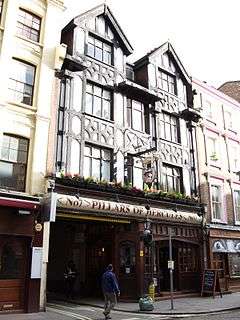Pillars of Hercules, Soho
| The Pillars of Hercules | |
|---|---|
 | |
| General information | |
| Address |
7 Greek Street London W1 |
| Coordinates | 51°30′52″N 0°07′52″W / 51.514558°N 0.131176°WCoordinates: 51°30′52″N 0°07′52″W / 51.514558°N 0.131176°W |
The Pillars of Hercules is a pub in Greek Street, Soho, London. Most of what exists was built around 1910, but the pub dates back to 1733.[1] Dickens referred to it in A Tale Of Two Cities, and the road at the side of the pub through the arch is named Manette Street, after Dr Manette, one of the characters from that book.[lower-alpha 1]
More recently, the pub has been favoured by many figures from the London literary scene, including Martin Amis, Ian Hamilton, Julian Barnes and Ian McEwan. Clive James named his second book of literary criticism (At the Pillars of Hercules) after it, apparently because that was where most of the pieces within it were commissioned, delivered or written.
The pub closed on 24 February 2018, a sign in the window announced that the pub would be back "with a fresh lick of paint" in April. It was confirmed that the Pillars would remain a pub, but reopen under new management.[4]
Notes
- ↑ Hercules Pillars tavern to which Richard Sheridan and his opponent Captain Thomas Mathews retired after finding Hyde Park, too crowded for them to fight their famous duel in 1772 was on the site where Apsley House now stands at Hyde Park Corner. [2] It was that tavern which was immortalised by Henry Fielding in The History of Tom Jones, a Foundling as the location where Squire Western resides when he first journeys up to London.[3]
Sources
- ↑ Pillars of Hercules at ultimatepubguide.com{dead link}
- ↑ Wheatley 2011, p. 19.
- ↑ Knight 1851, p. 789.
- ↑ "Famed Soho pub not shutting down". www.thedrinksbusiness.com.
References
- Wheatley, Henry Benjamin (2011), Round about Piccadilly and Pall Mall: Or, a Ramble from the Haymarket to Hyde Parkvb (illustrated ed.), Cambridge University Press, ISBN 9781108036504
- Knight, Charles, ed. (1851), Knight's cyclopædia of London, London, p. 789
External links
- https://londonist.com/pubs/the-pillar-of-hercules. Accessed 10 September 2017.